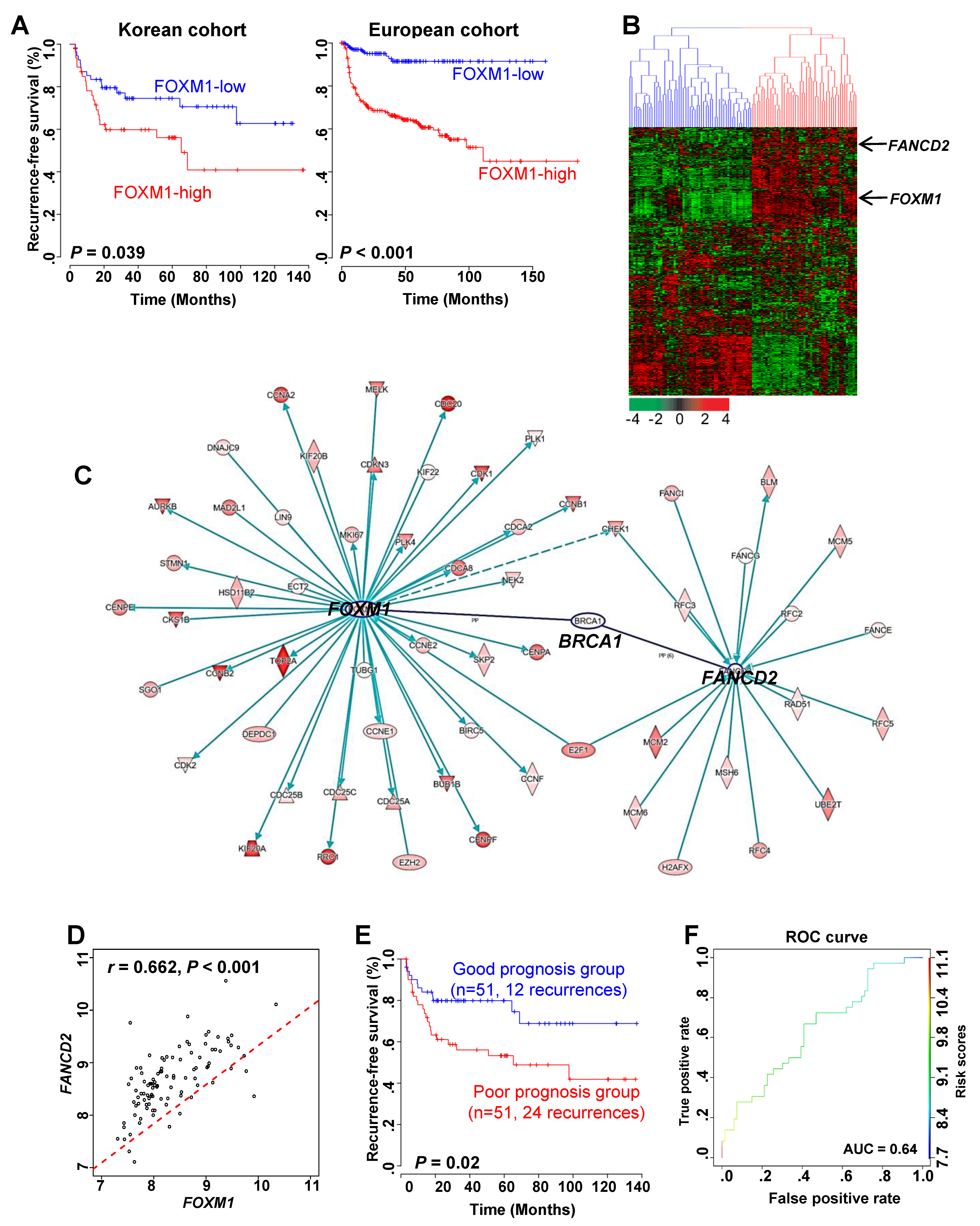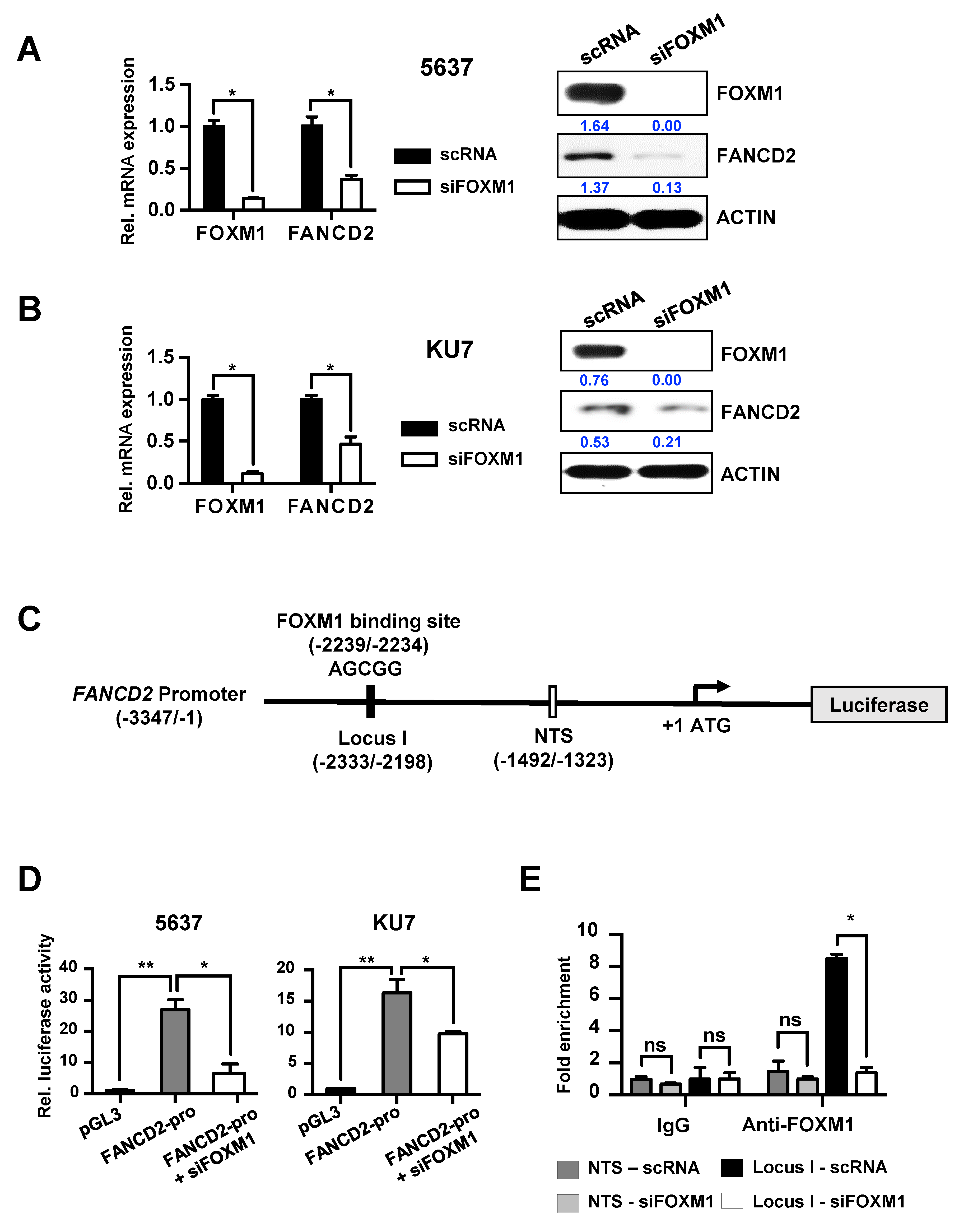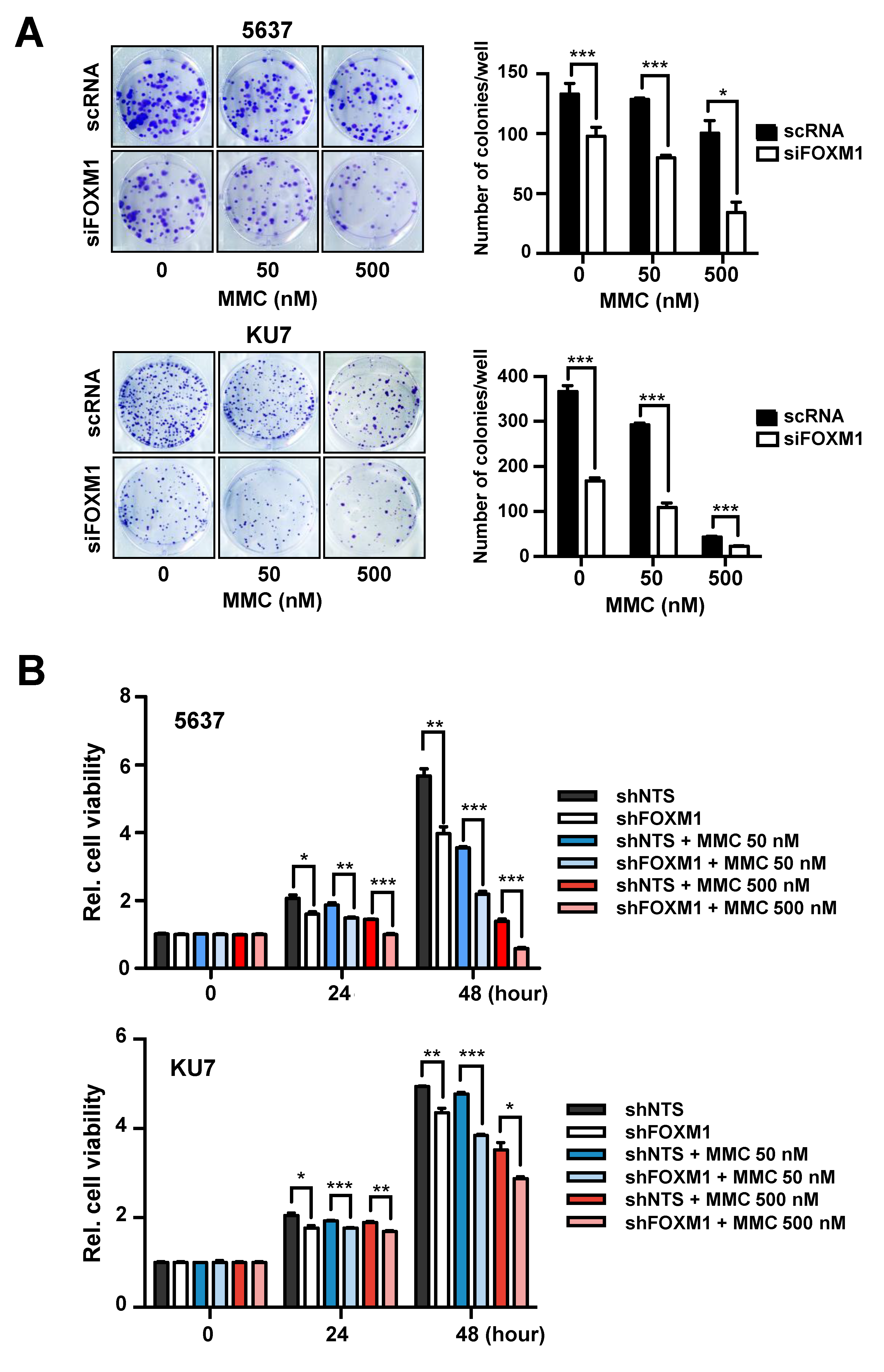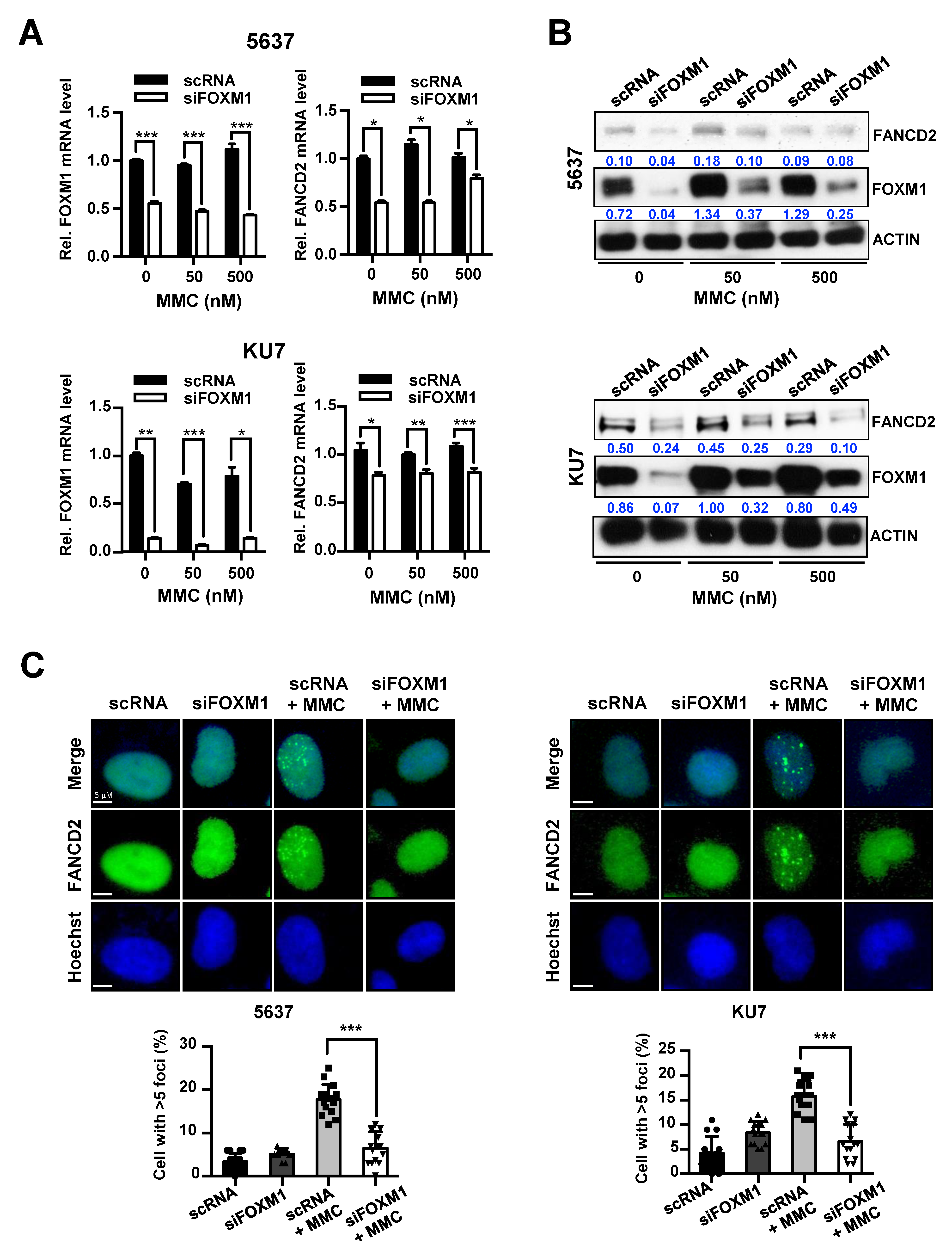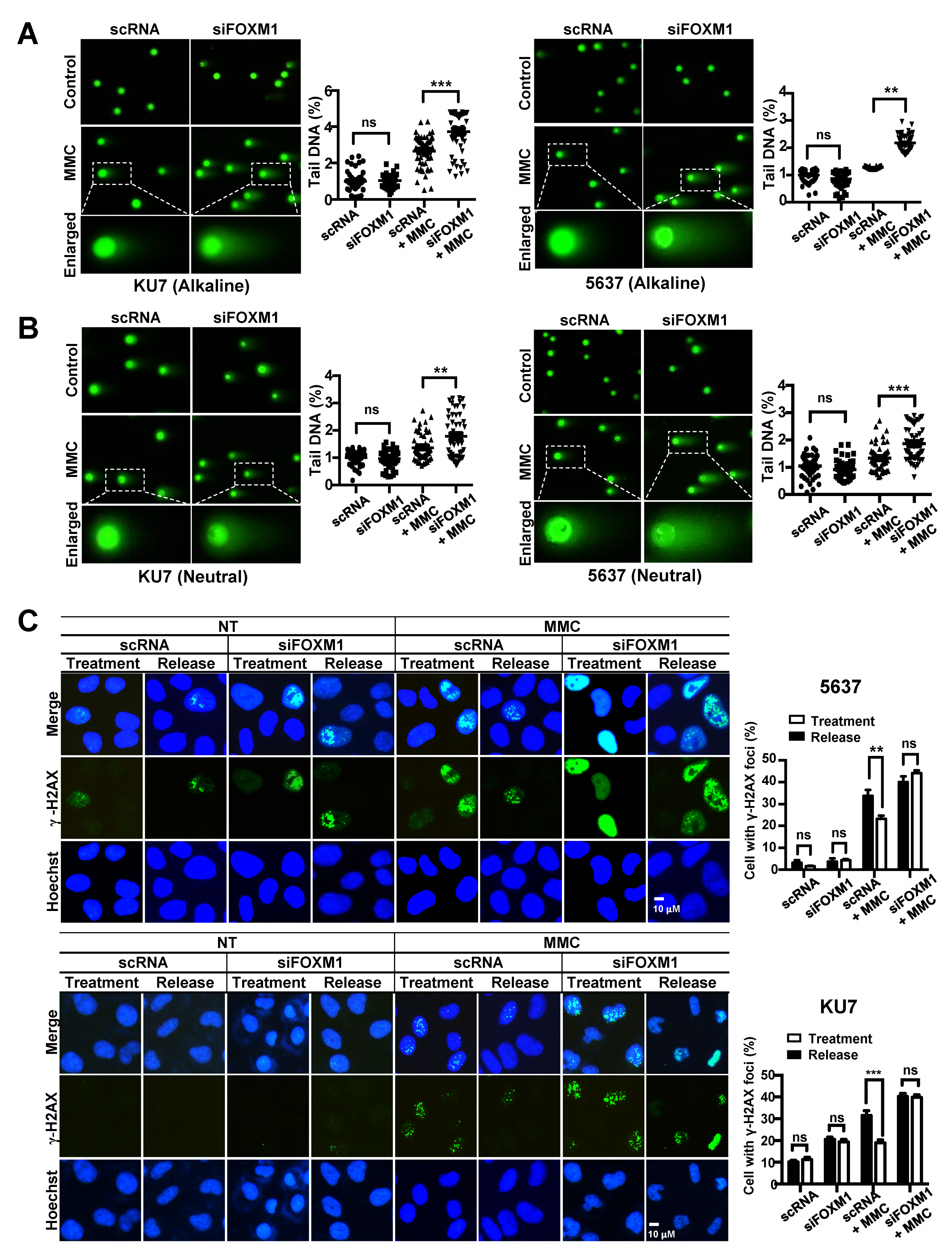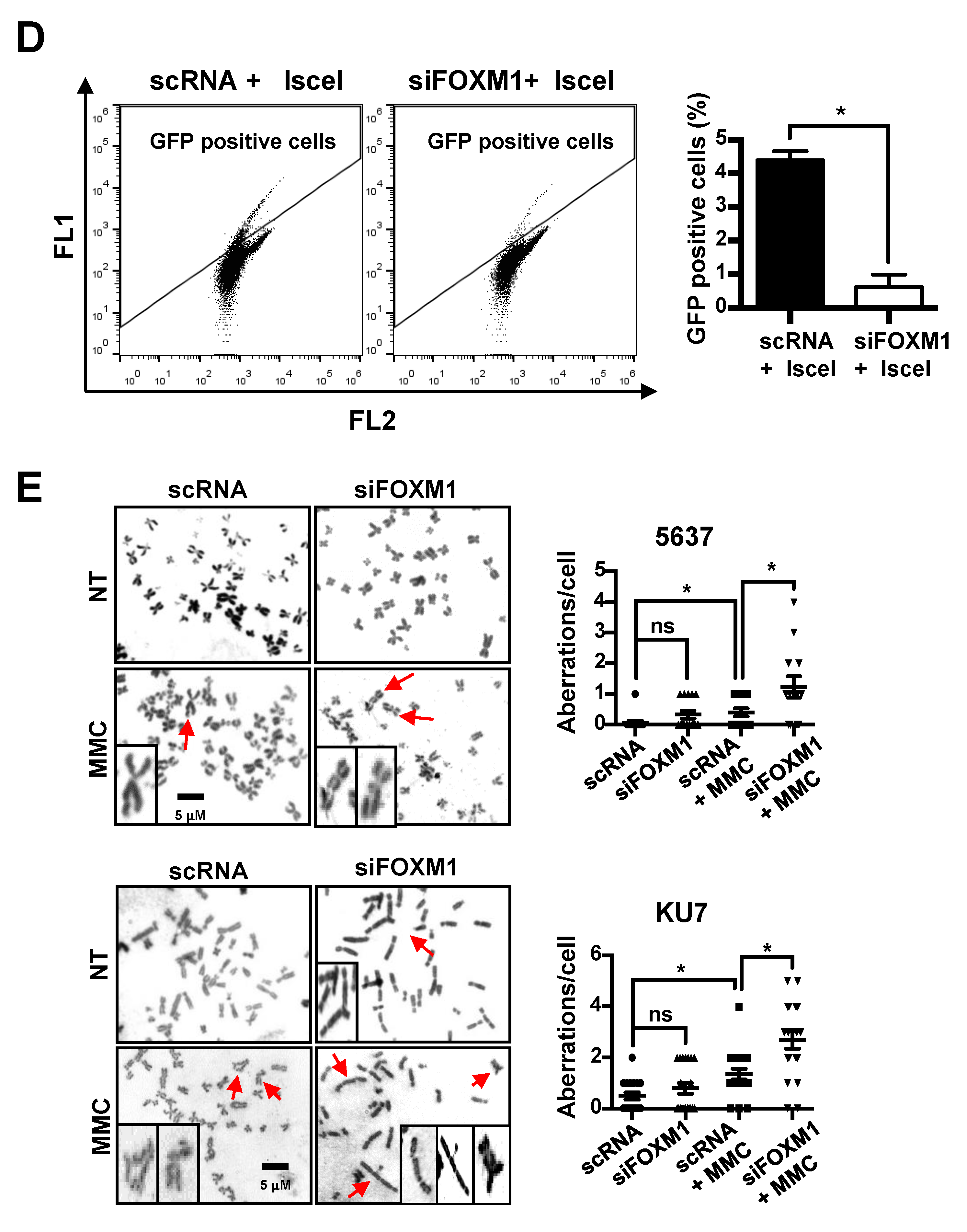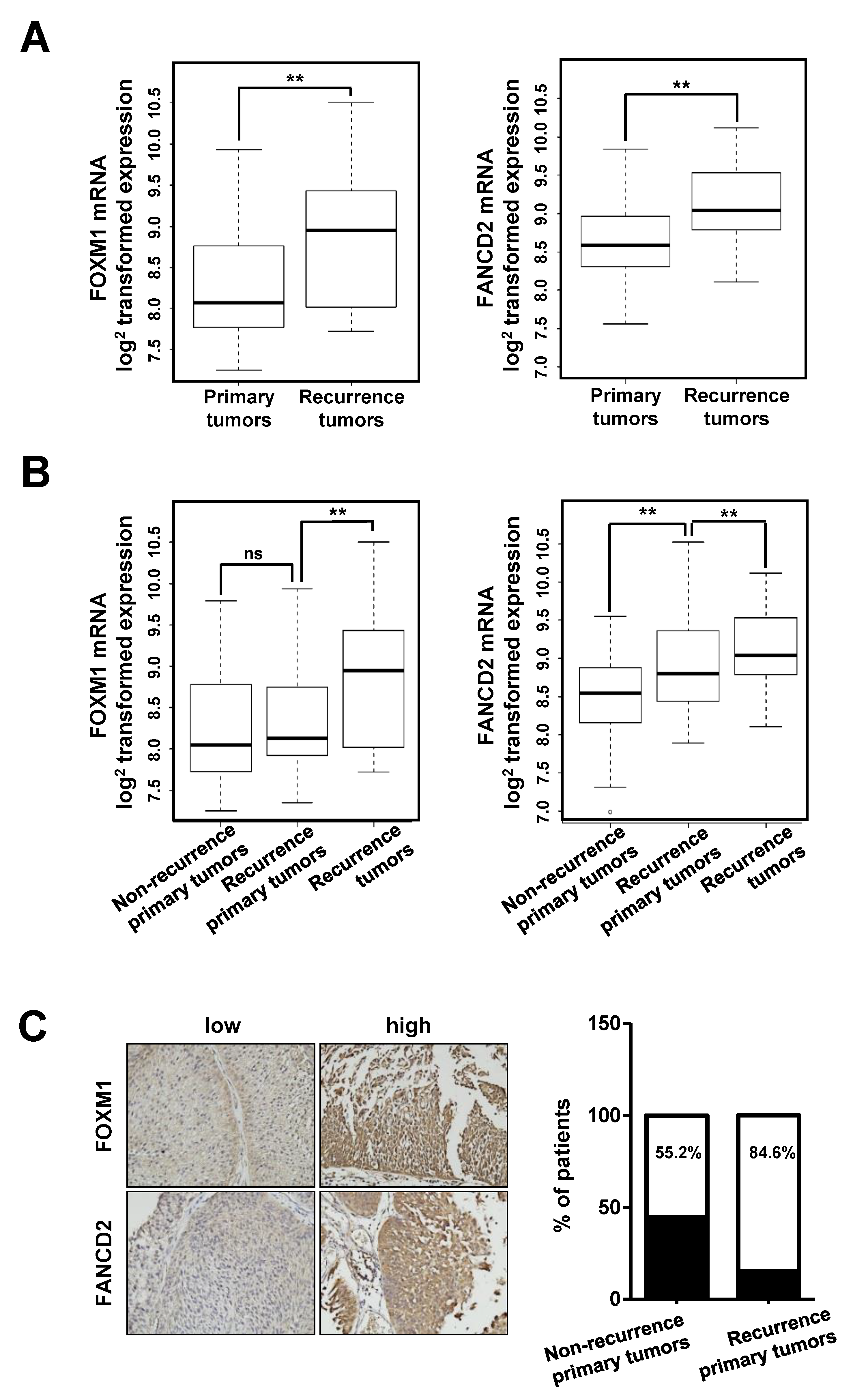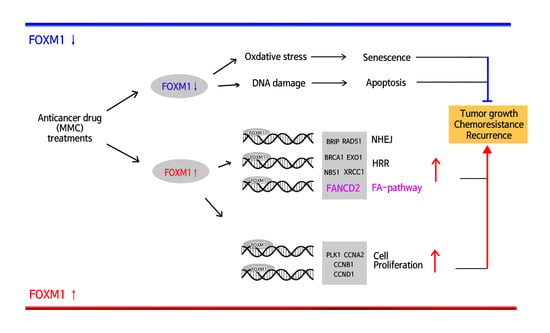1. Introduction
Bladder cancer (BC) is the fifth most frequent cancer among men, with an estimated 549,393 new diagnoses and 199,922 BC deaths per year worldwide (2018) [
1]. BC is classified into categories as nonmuscle invasive bladder cancer (NMIBC) or muscle invasive bladder cancer (MIBC) according to the presence or absence of muscle layer invasion [
2]. More than 70% of patients are diagnosed with NMIBC and are grouped into low, intermediate, and high risk according to the EORTC (The European Organization for Research and Treatment of Cancer) risk stratification table [
3,
4]. Among the three groups, high-risk NMIBC (T1, with high grade/G3, and/or carcinoma in situ (CIS)) results in poor prognosis and additional intravesical bacillus Calmette-Guerin (BCG) and anticancer drug treatments (doxorubicin (DOX) and mitomycin C (MMC)) are recommended after surgery [
5]. Despite these treatments, more than 50% of patients with NMIBC develop recurrence, and 10% to 30% of recurrent patients progress to MIBC [
6]. These reports indicate that traditional indicators such as tumor grade, T stage, and CIS used in the diagnosis of BC patients are not sufficient [
7]. It is essential that a new method be developed to complement the present diagnostic methods and provide insight into the molecular mechanism of recurrence. Yet, the precise mechanism of recurrence has not been clarified.
A recent hypothesis in recurrence is that small numbers of anticancer drug-resistant cancer cells in a tissue survive and proliferate to cause recurrence after chemotherapy [
8,
9]. To explore the biomarkers of recurrence in bladder cancer cell lines and bladder cancer tissues, we wanted to find the relationship between drug resistance and recurrence of bladder cancer. According to recent reports, anticancer drug resistance is caused by an increase in drug efflux, anti-apoptosis activity, and DNA damage repair [
10,
11]. Most of the current anticancer drugs used to treat cancer patients are designed to cause DNA damage and cell death [
12]. However, because cancer cells use various DNA damage repair mechanisms to repair DNA damage and prevent cell death, the inhibition of DNA damage repair in cancer cells has emerged as an important issue for effective chemotherapy [
12].
In previous studies, we found that patients with high expression of FOXM1 have a high risk of recurrence, suggesting FOXM1 could act as a recurrent biomarker [
13]. FOXM1 is a transcription factor known to regulate the progression of the G2/M phase [
14]. However, recent studies have shown abnormal overexpression of FOXM1 in various cancer tissues, such as those of the bladder, liver, prostate, brain, breast, lung, colon, pancreas, skin, cervix, ovary, and mouth [
15]. FOXM1 affects the abnormal functions of cancer cells, including proliferation, cell cycle progression, apoptosis, angiogenesis, and DNA damage repair [
16,
17,
18,
19,
20]. FOXM1 is associated with cancer metastasis, recurrence, and resistance to various chemotherapeutic drugs, such as DOX, epirubicin, and MMC [
21,
22]. FOXM1 is known to regulate the transcription of various DNA repair factors to increase homologous recombination (HR), nonhomologous end joining (NHEJ), base excision repair (BER), and mismatch repair [
23]. These reports suggest FOXM1 as a DNA repair regulator associated with resistance to various chemotherapeutic agents and proliferation.
DNA interstrand crosslinking (ICL) is known to be repaired by the FA pathway, which is one of the DNA repair pathways [
24]. MMC, which is used in chemotherapy for high-risk NMIBC patients, induces ICL and apoptosis, thereby eliminating cancer cells [
25,
26]. The FA pathway is a complex DNA recovery pathway known to recruit various DNA repair pathways, such as nucleotide excision repair (NER), homologous recombination repair (HRR), and translation synthesis (TLS) to restore ICLs [
24]. FOXM1 has been reported to be involved in many DNA repair processes, but there have been few direct reports of the FA pathway. However, our previous study of gene expression profile analysis identified FOXM1 and FANCD2 as recurrent biomarkers of bladder cancer [
13]. Among the FA pathway factors, FANCD2 is ubiquitinated by the FA core complex and is known as a key factor in completing ICL repair [
24]. During the FA pathway, a total of 19 FA proteins work together, and the FANCD2–FANCI protein complex restores ICL in the cell cycle S phase [
27]. Therefore, the expression of FANCD2 is expected to contribute to the resistance to MMC by ICL repair. However, the association of FANCD2 with FOXM1 and its transcriptional control mechanism is unclear.
Herein, we analyzed whether the transcription factor FOXM1 directly regulates the expression of FANCD2 and whether the increased expression of FOXM1 affects ICL repair by the FA pathway. We analyzed whether the transcription factor FOXM1 directly regulates the expression of FANCD2 and whether the expression of FOXM1 affects ICL recovery by the FA pathway. Through this study, we identified genes associated with NMIBC recurrence and chemotherapy resistance. These genes can be used as prognostic biomarkers for recurrence and anticancer drug resistance and have also revealed potential molecular mechanisms that could be the basis for developing new therapies.
3. Discussion
Although NMIBC is known to have a relatively high survival rate compared to MIBC, the incidence rate is expected to significantly increase with the increase in the elderly population [
25]. However, NMIBC has a high recurrence rate of over 50% and requires repeated treatment [
7]. Therefore, the cost of the treatment is inevitably high, which may result in a negative effect on the quality of life of the elderly population [
25]. Therefore, if biomarkers could be used to predict the recurrence of BC, accurate diagnosis and effective treatment could be conducted, which would prevent predicted recurrence problems.
Our previous studies have shown that recurrence significantly increases in NMIBC patients with high
CCNB1 expression [
13]. In addition, BCG, which is currently used in high risk NMIBC treatment, requires a definite treatment indicator, according to the current treatment standards, because of the risk of adverse effects in some patients with no therapeutic responses or serious side effects [
2]. Interestingly, our results showed that treatment with BCG can be more effective in patients with high
CCNB1 expression [
13]. These results indicate that
CCNB1 is a suitable biomarker since
CCNB1 expression can also be used as a criterion to clearly indicate whether therapy should be performed [
13]. However, the risk of side effects that may be caused by BCG still remain. The increased effect of BCG in the high
CCNB1 expression group was found as a result of demonstrating that immunotherapy is effective in a group of patients not responding to conventional chemotherapy [
13]. Therefore, if this group can increase the effectiveness of chemotherapy, then safe and effective treatment of BCG is possible.
In this study, we identified FOXM1 as a driver gene that is strongly associated with bladder cancer recurrence and is known to regulate expression upstream of
CCNB1. In addition, we could determine the recurrence rate of patients classified according to the expression of FOXM1 and FANCD2 (
Figure 1 and
Figure 2) and by using these genes as biomarkers in combination with
CCNB1 [
13], we could predict the prognosis of patients with NMIBC after the first surgery.
We also investigated the pathway through which FOXM1 acts to interfere with anticancer drug therapy and the mechanism of cancer recurrence. We examined the mechanism of the FANCD2 transcriptional regulation by FOXM1 (
Figure 3) and demonstrated that MMC-induced DNA damage is reduced by the inhibition of FOXM1 (
Figure 4 and
Figure 5). The transcriptional regulatory mechanism of FANCD2, a key element of the FA pathway, was confirmed. It is expected that the effect of MMC on chemotherapy can be increased by confirming decreased DNA repair activity as a result of decreased FANCD2 expression. Currently, the expression of FANCD2 did not increase by MMC treatment because MMC repressed DNA replication by inhibiting DNA replication and transcription to eliminate cancer cells. Our results demonstrate that the inhibition of the expression of FOXM1, the driver gene, in NMIBC recurrence can inhibit different anticancer resistance pathways. Although new drugs targeting FOXM1 have not yet been developed, natural substances that restrict FOXM1 and inhibitors have been identified [
26,
29]. Therefore, it is expected that more effective chemotherapy will be achieved if these substances are used in concert with anticancer drugs. In addition, NMIBC treatment will be more effective if anticancer drugs targeting FOXM1 are developed.
Previous studies have shown that FOXM1 can regulate
CCNB1 expression to induce cell proliferation and recurrence [
30]. The study also showed that FOXM1 can increase anticancer drug resistance by regulating the expression of FANCD2, which regulates the Fanconi anemia pathway and consequently increases DNA repair. Through this, we propose that FOXM1 directly regulates the expression of
CCNB1 and FANCD2 as an important pathway for recurrence and thereby is involved in cell proliferation and anticancer drug resistance.
In summary, we confirmed that FOXM1 can modulate the DNA repair pathway by directly regulating FANCD2 transcription and that it regulates resistance to MMC. Finally, in the case of FOXM1 and FANCD2, we confirmed that the expression could be used as a biomarker to predict recurrence and survival rates.
4. Materials and Methods
4.1. Cell Culture and Reagents
The 5637 and HEK-293T cells originated from the American Type Culture Collection (ATCC). KU7 and U2OS-DRGFP cells were provided by Ju-Seog Lee (The University of Texas MD Anderson Cancer Center, Houston, TX, USA). The 5637 cells were cultured in RPMI 1640 medium (HyClone, UT, USA) supplemented with 10% FBS (Fetal Bovine Serum, HyClone, UT, USA) and 1% penicillin/streptomycin (P/S, Gibco, NY, USA). HEK293T and KU7 cells were cultured in H-DMEM (HyClone) supplemented with 10% FBS and 1% P/S. The U2OS-DRGFP cells were grown in McCoy’s 5A (Modified) medium (Gibco, NY, USA), plus 10% FBS and 1% P/S. All cells were incubated at 37 °C under 5% CO2 in a humidified incubator. MMC, puromycin, and hexadimethrine bromide (polybrene) were purchased from Sigma (MO, USA) and were dissolved in sterile dH2O.
4.2. Plasmid, Small-Interfering RNA, and Transfection
pGL3-Basic and pRL-Renilla luciferase reporter plasmids were purchased from Promega (WI, USA). To generate the pGL3 Basic-FANCD2 promoter (from −3347 to –1), human genomic DNA was amplified by PCR using the indicated primer sets (
Table S2). We purchased shRNA for FOXM1 from Sigma. The plasmids that stably expressed a shRNA against
FOXM1 (shFOXM1) were established in a pLKO.1-TRC cloning vector (Addgene, MA, USA). We used a pLKO.1-puro nontarget shRNA plasmid (Sigma) for the negative control. pMD2.G and psPAX2 plasmids were purchased from Addgene (MA, USA). To construct pFANCD2 (FANCD2 overexpression vector), the coding sequence (CDS) of FANCD2 was inserted into the
NheI/
XhoI restriction enzyme sites of a pcDNA
TM6/V5-His A plasmid (Invitrogen, MA, USA). All constructs were verified using a DNA sequencing.
Scrambled RNA (scRNA) was purchased from Shanghai GenePharma (Shanghai, China). siFOXM1 (5’-GGACCACUUUCCCUACUUU-3’) was synthesized by the ST Pham Oligo Center (Korea). Plasmid and siRNA transfection were conducted using jetPRIME reagent (Polyplus, NY, USA) according to the manufacturer’s protocol.
4.3. Quantitative Real-Time PCR (qRT-PCR) and Luciferase Assay
All RNA was obtained from BC cells using RNAiso (TAKARA, Shiga, Japan) according to the standard protocol, and the synthesis of complementary DNA (cDNA) and qRT-PCR were performed using a PrimeScript RT reagent kit (TAKARA) according to the manufacturer’s instructions. cDNA was amplified using qRT-PCR with the indicated primer sets (
Table S2) and CFX960 Optics Module (Bio-Rad, CA, USA). Amounts of mRNA were determined from the threshold cycle number with the expression of L19 as an endogenous control. All experiments were performed in triplicate and the values were averaged.
Luciferase assays were performed as described previously [
31]. They were carried out using a Dual-Luciferase Reporter Assay System (Promega). To measure luciferase activity, a Wallac Victor 1420 Multilabel counter (PerkinElmer, MA, USA) was used. All firefly luciferase data were normalized to Renilla luciferase activities, each experiment was replicated three times, and the values were averaged.
4.4. Microarray
We analyzed a gene expression dataset from a previous study (GSE13507) that involved 165 primary Korean BC tissues. Among the 165 tissues, 102 tissues were identified as primary NMIBC. Clinical data including recurrence-free survival were acquired from the Chungbuk National University Hospital (Cheongju, South Korea). To estimate recurrence values of a signature combined with FOXM1 and FANCD2 genes, we selected a strategy that, for the genes in its signature, used the Cox regression coefficient (prognostic index (PI)). Ingenuity Pathway Analysis (IPA) was used to analyze the gene network-based activation regulator. Other gene expression datasets of BC patients with NMIBC from hospitals in the Swedish southern healthcare region (GSE32894; the SSH cohort, n = 213), Skane University Hospital (GSE32549; the SUH cohort, n = 92) and RNA sequencing data set (TCGA-BLCA; n = 412) were used to identify FOXM1 expressed genes. All gene expression datasets were opened at the National Center for Biotechnology Information (NCBI) Gene Expression Omnibus (GEO) database.
4.5. Generation of Stable Cell Lines
HEK-293T cells were transfected with pMD2.G (envelope plasmid), psPAX2 (packaging plasmid), and shRNA expressing plasmid (shNTS or shFOXM1) using jetPRIME reagent. The medium was changed 12 hours later and was harvested from the cells after 24 hours. The 5637 and KU7 cell lines were transduced with medium containing lentiviral particles and added polybrene was added. The cells stably expressing shRNA against NTS (shNTS) or FOXM1 (shFOXM1) were selected puromycin (5 μg/mL). FOXM1 mRNA and protein expression in cell lines was confirmed using qRT-PCR and Western blot assays.
4.6. Western Blot and Chromatin Immunoprecipitation (ChIP) Assay
Western blotting was performed as described previously [
31]. Blots were conducted using the following antibodies: mouse-anti-β-Actin (A5441, Sigma), rabbit-anti-FOXM1 (Cat.A301-533A, Bethyl Laboratories, TX, USA), rabbit-anti-FANCD2 (Cat.NB100-182, Novus Biologicals, CO, USA). Horseradish peroxidase-linked goat anti-rabbit IgG polyclonal antibody (Cat.ADI-SAB-300-J, Enzo Life Sciences, NY, USA), and goat anti-mouse IgG polyclonal antibody (Cat.ADI-SAB-100-J, Enzo Life Sciences). Equal protein loading verified by detection of β-actin expression.
ChIP assays were performed as described previously [
32]. Immunoprecipitation was performed using a rabbit-anti-FOXM1 antibody (Cat.A301-532A, Bethyl Laboratories, TX, USA). The indicated primer sets used for PCR amplification were a primer set for the FOXM1 site at position (
Table S2).
4.7. Colony Formation Assay and MTT Assay
siRNA-transfected BC cells were seeded in 6-well plates at 1000 cells/well and then were incubated for 24 hours. Afterwards, the cells were treated with the indicated concentration of MMC for 24 hours. Then, the cells were harvested and reseeded in 6-well plates at 100 cells/well. After 2 weeks of incubation, colonies were fixed with 4% paraformaldehyde for 15 minutes at room temperature before being washed with PBS (Phosphate-buffered saline). Crystal violet (0.5%; Sigma) was used to stain the fixed cells for 30 minutes, which was followed by washing the plates with dH2O. The plates were then left to dry overnight. Colonies were counted using Carl Zeiss Axiovert 40 CFL microscopy (Göttingen, Germany).
MTT assays were performed as described previously [
31]. Absorbance for each well was determined at 540 nm with a Wallac Vector 1420 Multilabel Counter (PerkinElmer, MA, USA). For each experimental condition, 3 wells were used.
4.8. Immunofluorescence
BC cells were seeded on coverslips coated with collagen (Sigma). Cells were treated both with 0.5 μM MMC, and control cells were untreated. After treatment, cells were washed with PBS and then fixed with 2% formaldehyde in PBS at room temperature (RT) for 20 minutes. After being washed with PBS, the process was followed by permeabilization with 0.5% Triton X-100 (Fluka, Buchs, Switzerland) in PBS at RT for 30 minutes. Then, cells blocked with 20% FBS were probed with the following antibodies in 5% FBS of PBS for 2 hours at RT: FOXM1 antibody (Cat.A301-533A, Bethyl Laboratories), FANCD2 antibody (Cat.NB100-182, Novus Biologicals, CO, USA), and phosphor-histone H2AX antibody (Cat.04-636, Millipore, MA, USA). After being washed with PBS, the cells were incubated with mouse and rabbit IgG-heavy and light chain antibodies (Cat.A90-116F, A120-101D4, Bethyl Laboratories) for 1 hour at RT and then were washed with PBS. Cells were costained with 100 μg/mL Hoechst 33342 and then were mounted with Vector Vectashield mounting media (Vector Laboratories, CA, USA). After fluorescence images were acquired using an LSM 700 confocal microscope (Carl Zeiss, Göttingen, Germany), the cells were counted in at least four randomly selected fields.
4.9. Comet Assay
BC cells (1 × 106 cells) were harvested after treatment with 0.5 μM MMC for 24 hours and combined with molten LMAgarose (Trevigen, MD, USA). Before being incubated at 4 °C in lysis solution (Trevigen) overnight, cells were embedded in low melting agarose on a glass slide. Under alkaline conditions, slides were then immersed in an alkaline unwinding solution (200 mM NaOH, 1 mM EDTA, pH >13) in the dark at room temperature for 40 minutes before being placed in an electrophoresis slide tray. In addition, 850 mL of cold alkaline electrophoresis solution (200 mM NaOH, 1 mM EDTA, pH >13) was added, and a set power of 20 volts was applied for 30 minutes. Slides were first washed in dH2O twice for 5 minutes each and then in 70% EtOH for 5 minutes. Under neutral conditions, the slides were submerged in 1 × neutral electrophoresis buffer (10 × neutral electrophoresis buffer diluted 1:10 in dH2O 60.57 g Tris-Base, 204.12 g sodium acetate, pH = 9.0 with glacial acid) for 30 minutes. The slides were placed in an electrophoresis slide tray with 850 mL of cold 1 × neutral electrophoresis buffer, and a set power of 20 volts was applied for 45 minutes. The slides were then submerged in DNA precipitation solution (7.5 M NH4AC, 95% EtOH) for 30 minutes at room temperature. After they were washed with 70% EtOH for 30 minutes, they were dried at 37 °C for 15 minutes. Slides were then stained with SYBR Green for 30 minutes in the dark. Slides were rinsed in dH2O and finally were mounted using Vectashield mounting medium. Nuclei were visualized by fluorescence microscopy. The percentage of DNA was quantitated for 50 cells by using a microscope.
4.10. Homologous Recombination Assay and Chromosomal Aberration Assay
U2OS cells stably transfected with a DR-GFP plasmid vector were used for the HR assay. A total of 1 × 105 siRNA-transfected cells were plated in a 6-well plate. Twenty-four hours later, the I-SceI endonuclease plasmid was delivered into the cells by transfection for 24 hours. Then, the cells were washed with PBS and harvested using trypsin. Then, cells expressing GFP were sorted by flow cytometry FC500 (Beckman Coulter, Krefeld, Germany) at 520 nm to analyze the efficiency of HR repair using the CXP v2.1 program.
For the detection of chromosomal aberration, siRNA transfected BC cells were treated with 0.5 μM MMC. Twenty-two hours later, the cells were exposed to 100 ng/mL colcemid (Sigma) for 2 hours. Then, the cells were treated with a hypotonic solution (75 mM KCl) for 20 minutes and then were fixed with 3:1 methanol/acetic acid. Slides were stained with a Giemsa solution (Sigma), and over 50 metaphase spreads were counted to detect aberrations. The relative number of chromosomal breaks and radials was calculated relative to scRNA or siFOXM1.
4.11. Immunohistochemistry (IHC) Staining and Antibodies
IHC was performed on a subset of 57 BC tissues from nonrecurrent primary cancer patients and recurrent primary cancer patients. A tissue microarray (TMA) was created from 30 nonrecurrent tumors, and 27 recurrent tumors were used. IHC was performed with a panel of antibodies against 2 markers (FOXM1 and FANCD2). All stained slides were digitalized with an SL801 autoloader and a Leica SCN400 scanning system (Leica Microsystems; Concord, Ontario, Canada) at a magnification equivalent to 20×. The images were subsequently stored in a Slide Path digital imaging hub (Leica Microsystems) at the Vancouver Prostate Centre. Values were assigned on a 4-point scale for each image. Descriptively, 0 represented no staining, 1 represented a low but detectable degree of staining, 2 represented a low detectable degree of staining, 3 represented clearly positive cases, and 4 represented strong expression. IHC was quantified for staining intensity (0–4).
4.12. Statistical Analysis
Data are represented as the mean ± SEM of three independent experiments. Unpaired Student’s t-tests were used to analyze the dissimilarities between the groups. Categorical data were analyzed by Fisher’s exact test. The cumulative recurrence was calculated by the Kaplan–Meier method and the log-rank test. Analyses were performed using GraphPad Prism 7 software (GraphPad Software, Inc., CA, USA). Asterisks, as described in the figure legends (ns, not significant; *, p < 0.05; **, p < 0.01; and ***, p < 0.001), were used to illuminate the statistically significant p-values that were less than 0.05.
